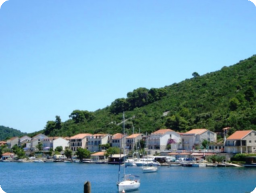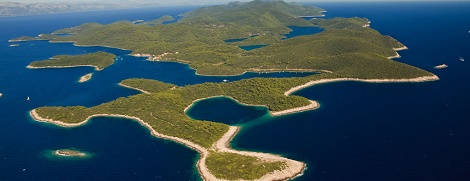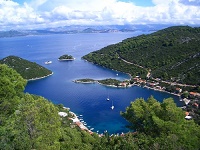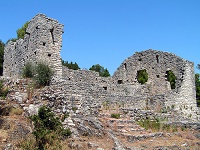

Polače/island of Mljet
Polače/island of Mljet  The history box
The history box

Nowhere in the world do greenness and blueness go together so strongly as on Mljet, and nowhere in this two-coloured play can you enjoy as much peace and security as in Polače Bay, which opens up under the natural breakwater of four islands deep into the northern side of the island of Mljet.  There are six ways of sailing into the bay between the islands (Kobrava, Tajnik, Ovrata and Moračnik), all of them safe, except the westernmost between Moračnik and Mljet. Whichever route you choose, you will be on the border of different worlds: the channel on one side, the green island on the other, one side windy and the other windless.
There are six ways of sailing into the bay between the islands (Kobrava, Tajnik, Ovrata and Moračnik), all of them safe, except the westernmost between Moračnik and Mljet. Whichever route you choose, you will be on the border of different worlds: the channel on one side, the green island on the other, one side windy and the other windless.
The sea in Polače is not one out of blue dreams of perfect swimming conditions. The bottom here is not particularly deep; it is muddy and full of marine vegetation. Therefore, you should have a good swim near one of the islands before entering the calmness of Polače, and even then you should prepare yourself for a meeting of past and present times and mentalities.
Polače is the ideal place for such thoughts. The name goes back to ancient times when the Romans in this God-given harbour built a structure that is now the third largest and best preserved Roman monument on the coast, after Diocletian's Palace in Split and the Arena in Pula. Before the Romans, the Illyrians used to live here (some historians place their settlement of Melitusa in Polače), and findings from the 4th century BC also point to Greek sailors who sailed through the Mljet Channel towards their colonies on the islands of Korčula, Vis and Hvar. The Belgrade sailor and amateur Homerologist Zlatko Mandžuka goes even further and argues that when Odysseus got lost in the Adriatic in Circe's erotic slavery, he stayed on Mljet, though not in Polače but on the other side of the island. Mandžuka located Circe's palace in Okuklje.
Greek sailors would have stayed in Polače not only for protection but also for the drinking water that exists to this day, as shown by findings of amphorae under the water. There are no Greek remains on land, and what we now call the remains of the Roman palace in Polače was actually a defensive unit consisting of an ancient palace, thermae, two Early Christian basilicas, an arsenal, a warehouse for galleys and the remains of piers (now located under the sea). The remains of the columns the Roman galleys used to moor to are located all over the harbour.  In the 5th century, this Roman property provided 500 solidi of income annually, and salt, wine, olive oil, honey, meat, sheep and goat cheese, and dried and salted fish were also produced. Since no remains of a settlement have been found, it is believed that Polače was a large marina for the wintering of Roman galleys.
In the 5th century, this Roman property provided 500 solidi of income annually, and salt, wine, olive oil, honey, meat, sheep and goat cheese, and dried and salted fish were also produced. Since no remains of a settlement have been found, it is believed that Polače was a large marina for the wintering of Roman galleys.
According to legend, the palace, modelled on Roman villages from the imperial era, was built by Agesilaus from Anazarbus in Cilicia. Agesilaus, along with his son, the poet Oppian, took shelter on Mljet after the Roman Emperor Septimius Severus banished him from court. The story goes that the Emperor Caracalla freed them from captivity after the poet wrote inspired verses about the beauty of the sea and fishing. Oppian and his father refused to return to Rome, explaining that they would never change their little empire for a large one, and sent an Aleppo pine branch with a shell in a bird's nest to the Emperor. Even today, no one knows exactly when the palace was built, but there is no doubt that Augustus had the first property built after he took over Mljet. But why have I been talking about the palace in Polače so much? I guess it is because each new encounter raises the question of why structures were once built to please both the spirit and the eye, and now it seems that it is hard to tell which of the aspects - the visual or the spiritual - suffers most. This question can indeed be asked anywhere in the Adriatic, but nowhere more strongly than in Polače. Please don't hold my honesty against me, but everything except the Roman remains coincides with devastation.
During the times of the Socialist Federative Republic of Yugoslavia the idea existed that the population of the older part of Polače should move to the newer part and that the houses should be torn down in order to completely rebuild a palace on their foundations, together with a museum of the island of Mljet. Money was collected for the project, but the idea was abandoned in 1979 when all the money for the palace was used for the reconstruction of Dubrovnik and Kotor, which had been severely damaged by an earthquake. It is difficult to speculate how the project would have finished if it had been carried out under the strict eye of the restorers, but there is no doubt that the urban and civilisation traditions in Polače are in need of change. This is all the more so since, owing to the historically unrecorded and, of course, involuntary co-operation between the Benedictines and communists, an oasis has been preserved in the park. We are talking about the lakes of Mljet, around 10 minutes' walk through the shade of pine trees from Polače, and for many the main reason for anchoring in Polače.
This is all the more so since, owing to the historically unrecorded and, of course, involuntary co-operation between the Benedictines and communists, an oasis has been preserved in the park. We are talking about the lakes of Mljet, around 10 minutes' walk through the shade of pine trees from Polače, and for many the main reason for anchoring in Polače.
The lakes are actually a bay formed by a rise in the sea level and the flooding of karst valleys that look like lakes (hence the name). The lakes include Veliko Jezero and Malo Jezero, which are connected by an artificially deepened passage. An artificially expanded channel connects Veliko Jezero with Soline Bay. These are the facts, but now it is time for you to enjoy your stay and swim in the lakes.
On Veliko Jezero, on the island of Sveta Marija (St. Mary), the Benedictines built a church and monastery in the 12th century, turning them into a hotbed of culture of the Dubrovnik literary circle. In the socialist period, the monastery was turned into a hotel and was called Melita after the island's former name. In the meantime, it was returned to the possession of the Church. Where, then, did the expression "Benedictine-communist coalition" come from?
Thanks to the selective eye of Comrade Tito, the latter knew how to identify cultural and natural heritage and in 1960 proclaimed it a national park. I am confident that without this status conditions on Mljet would be far worse. But hasn't the time come for the park and local population to bring the past form of coexistence to a higher civilisational level? I am sure that the majority of sailors that come to Polače would answer this question affirmatively.
About the author:
Josip Antić was born in Šibenik, and Šibenik Bay was the first sea that he set sail in. As a journalist, he worked for numerous Croatian daily and weekly newspapers and portals, reporting during both war and peace from Parliament and the streets. He also spent a number of years as an editor. He remembers only those articles and reports he published about the sea and from the sea, spending time with fishermen, yachtsmen, sailors, caulkers and seagulls. For more than 10 years he was the editor of a nautical magazine.
He lives and works in Zagreb and sails in the Adriatic when he is able to.

Video
Current news
 Macrocruise charter agency
Additional discount on the boat rental price of betw
Macrocruise charter agency
Additional discount on the boat rental price of betw























